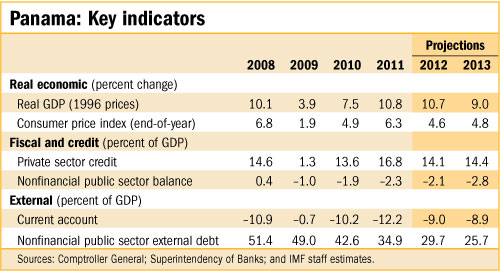
Typical street scene in Santa Ana, El Salvador. (Photo: iStock)
IMF Survey : Panama: Growth to Remain Buoyant
March 28, 2013
- Panama is fastest-growing country in Latin America
- Risks stem mainly from unsettled external environment
- Further reforms needed to transition to sustainable, inclusive growth
With average annual growth rates of 8.5 percent, Panama’s per capita GDP has more than doubled over the past decade. This impressive growth performance has been driven by a steady rise in public and private investment in a stable economic environment buttressed by prudent policies.

Worker at Panama Canal, Panama: the country’s economy has been buoyed by large infrastructure projects (photo: Luis J. Jimenez/Zuma Press/Newscom)
Economic Health Check
In its latest assessment of the Panamanian economy, the IMF said Panama’s economy continues to grow strongly, buoyed by the Panama Canal expansion and large public infrastructure projects. Real GDP growth is estimated to have reached 10.7 percent in 2012, the report said.
Macroeconomic stability anchored by full dollarization has favored the expansion of domestic services and activities centered around the Panama Canal and the Colón Free Zone. A successful fiscal consolidation brought gross public debt from 66.2 percent of GDP in 2005 to 39.2 percent of GDP in 2012.
Together with strong growth and a sound financial sector, this has led to Panama obtaining its investment grade in 2010. Following a recent upgrade by Moody’s, Panama is now among the highest rated emerging markets, on par with Brazil, Mexico, and Peru.
The IMF also welcomed the resilience of Panama’s financial system in light of recent global market turbulence, which can be explained by the banking system’s diversified ownership structure, low reliance on wholesale funding, as well as high capital and liquidity ratios.

Building greater resilience to shocks
For 2013, the IMF expects real GDP growth to decline to 9 percent and to gradually converge to its potential rate of 6–6½ percent over the medium term as capital spending unwinds. In light of Panama’s impressive growth performance, the IMF noted that a somewhat tighter fiscal stance would be desirable to mitigate overheating risks and build fiscal buffers.
As it is a highly open economy, both financially and commercially, Panama is vulnerable to external shocks. The country is closely linked to both the U.S. business cycle as well as to world trade, through the Panama Canal.
Panama is also an important regional banking hub, and linkages between the financial sector and the real economy are significant due to the size of the banking sector. IMF analysis indicates that external real and financial shocks, such as lower demand from the United States or a sudden stop in capital flows to Latin America, could have a significant impact on Panama’s output and credit growth.
However, strong fundamentals and low vulnerabilities, including a reliance on stable services exports and relatively small and shallow capital markets would mitigate the impact of external shocks. The creation in 2012 of a Sovereign Wealth Fund to save the additional revenue from the expanded Panama Canal (starting in 2015) will enhance the economy’s resilience to shocks over the medium term.
Sustaining growth over the medium term
Panama’s future growth prospects are bright. New investment opportunities stemming from infrastructure development and the expanded Panama Canal, the recent approval of Free-Trade Agreements with the United States, the European Union, and Canada, as well as a large private mining project should help support growth over the medium term, the IMF said.
Nonetheless, with these opportunities also come challenges. Poverty and inequality, although declining, remain fairly high compared with peer countries in the region. With historically low unemployment, there is a scarcity of skilled workers—but youth unemployment is high.
In this context, a comprehensive reform agenda is needed to support sustainable and socially inclusive growth. This will require boosting human capital and maintaining labor market flexibility to improve productivity and competitiveness.
Indeed, the government has started to implement initiatives to increase school attendance, modernize curricula to align them with skills demand, enhance access to technology in the classroom, and increase the provision of vocational training in partnership with the private sector. These efforts should help alleviate skills mismatches and ensure better opportunities for all Panamanians.
Further upgrades to public institutions and financial sector supervision and infrastructure will be required to ensure Panama’s successful transition to a modern service-based economy and a world-class financial center, the report also noted. Improvements in public financial management are essential to ensure that the large public investments in infrastructure are of high quality.
Raising tax revenue—which, at 12 percent of GDP, remains low compared with peers—would be necessary to sustain an appropriate level of social and capital spending. Efforts to strengthen tax and customs administration should focus on continuing to improve tax education, strengthen controls, and further reduce tax evasion and exemptions.


